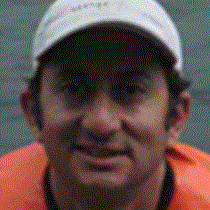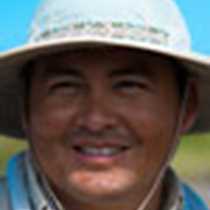The early start was a lure to many of our guests, photographers and naturalists alike, who landed at 6:00 a.m. with the first light of day.
Espumilla is a beautiful golden beach, a large nesting ground for black sea turtles, where hundreds and hundreds of ghost crabs busily filter the sand for marine morsels deposited by the retiring tide. The walk took place while a gentle ground swell pounded the shore and some of the turtles headed back to sea after a night of nesting.
Everyone was back for a late breakfast and a little downtime while National Geographic Endeavour was re-positioning to the famous Buccaneer’s Cove where the main water activities for the day were to take place. We snorkeled amongst large schools of tropical fish, with sightings of white tip reef sharks and spotted eagle rays. Kayaking was a lot of fun as we witnessed the rolling swell hitting the tuff stone walls, eroding processes that have broken the impressive cliffs through millennia. We paddled, leaving a safe distance, but close enough to feel the power of the ocean. Some of our guests enjoyed the underwater world by boarding the glass bottom boat, a great way to experience such a hidden treasure.
It is very clear why this spot made such an impression on Charles Darwin who attempted a drawing, and ended up wonderfully describing the colorful layers of substrate formed on both sides of a purple beach. This anchorage was also a favorite hide away for British privateers who roamed these waters in the late 1600’s and early 1700’s, a place where careening their ships was possible due to the steepness of the shoreline…they were also the first people to have described such a beautiful corner of our archipelago.
In the afternoon, after another short displacement and great lunch, we arrived to the southernmost point of James Bay, also known as Puerto Egas. We had a wet landing on a black beach surrounded by rolling hills of tuff stone. Once there, some of us stayed snorkeling with the cheeky sea lions, sharks, rays and turtles…the usual Galapagos stuff!
Those that weren’t snorkeling went for a land visit consisting of a walk to the Galapagos fur seal grottos, partially collapsed lava tubes full of seawater that provide these endemic pinnipeds with shade and protection. These natural pools, where fur seals cool down by rolling around in the water, are surrounded by hardened lava. Ledges and hollow areas, typical of volcanic formations, are used by these animals as essential protection from the scorching heat and the equatorial sun. The visit to this colony is magnificent as the arches between segments of lava flow, the tubes themselves, as well as the entire topography are so different from any other visitor site. The return trail followed the coastline, having the eastern side of Isabela Island and its five shield volcanoes, as a permanent background across the blue waters. The incredibly mixture of tuff stone with non-fragmented basalt littered by piles of basking marine iguanas, coastal and migrant birds feeding on the tide pools, sea lion pups awaiting for mother’s return with much needed milk were the delight of our lucky travelers.
What a day: we had a talk from one of our photo experts, a preview of the video made by our onboard video chronicler, a lecture from Carlos our expedition leader, a BBQ on deck… and the Galapagos National Park all to ourselves. We learned lots, shared lots and experienced a lot of new things. GALAPAGOS RULES!





